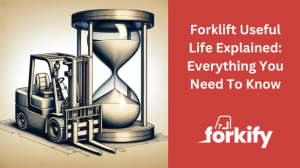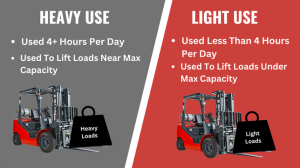If you’ve ever wondered just how long your forklift can serve you reliably, or how you can squeeze every bit of value out of this essential piece of machinery, then you’re in the right place. Forklifts are the unsung heroes of warehouses, construction sites, and manufacturing floors worldwide, playing a pivotal role in the smooth operation of countless businesses.
However, like any hardworking companion, they have their limits. In this guide, we’ll dive deep into what determines a forklift’s useful life, from the wear and tear of daily tasks to the maintenance schedules that can extend their service years.
Understanding Forklift Useful Life

Understanding a forklift’s useful life involves assessing how long it can efficiently operate, influenced by maintenance practices, workload intensity, and the operating environment. Let’s dig a little deeper into each:
What Exactly Is “Useful Life”?
Useful Life refers to the expected timeframe during which a forklift can operate efficiently and reliably, before the need for significant repairs or replacement arises.
This period is not just a simple estimate, it’s a critical metric that helps businesses plan for depreciation, maintenance schedules, and budgeting for future equipment needs.
Key Factors Affecting A Forklift Useful Life:
Maintenance Practices:
The lifespan of a forklift is heavily influenced by regular maintenance and repair practices. Scheduled servicing, timely replacement of worn-out parts, and adherence to manufacturer’s guidelines play a pivotal role in extending a forklift’s operational life. Proper maintenance ensures that the forklift remains efficient and safe to operate, reducing the likelihood of unexpected breakdowns and costly repairs.
Heavy Use vs. Light Use
The way a forklift is used whether under heavy or light conditions significantly impacts its useful life. Heavy use typically involves operating the forklift for multiple shifts per day, often in demanding environments. This level of usage accelerates wear and tear on the machine’s components, from the engine and transmission to tires and hydraulic systems, necessitating more frequent maintenance and potentially shortening the lifespan of the forklift.
Conversely, light use might consist of single-shift operations with moderate lifting demands, primarily indoors or in less harsh environments. Forklifts in these conditions experience less strain, leading to slower wear and potentially extending their useful life well beyond the average expectancy.

Operating Environment:
Environmental conditions where the forklift operates also dictate its durability and efficiency over time. Extreme temperatures, exposure to corrosive materials, and working in dusty or wet conditions can lead to faster degradation of parts and systems. Forklifts used indoors in controlled environments tend to have a longer useful life compared to those used outdoors where they are subject to varying weather conditions and rougher terrains.
Electric vs. Internal Combustion Forklifts: Comparing Useful Life
Each type offers distinct advantages that affect their longevity differently here’s a breakdown:
Electric Forklifts: Known for their longer lifespan, electric forklifts benefit from having fewer moving parts and using clean energy, leading to less wear and tear. They require less maintenance and are better for indoor environments, as they emit no pollutants. The main consideration is the battery, which is costly to replace and lasts about 5 years.
Internal Combustion Forklifts: IC forklifts, powered by gasoline, diesel, or propane, typically have a shorter lifespan due to the more complex and demanding combustion process. They need more frequent maintenance but offer quick refuelling, making them suitable for continuous outdoor use. Their upfront cost may be lower, but they tend to incur higher operational costs over time.
Lifespan Considerations: The useful life of both types depends on usage, maintenance, and environment. Electric forklifts can last longer but involve higher initial and battery replacement costs. IC forklifts, while possibly cheaper initially, may have higher maintenance expenses.
What’s The Average Lifespan Of A Forklift?
The average lifespan of a forklift varies widely depending on several factors, including its maintenance schedule, the intensity of its workload, and the conditions under which it operates. Generally, a well-maintained forklift can last between 10,000 to 20,000 operating hours.
Translating these hours into years depends on how frequently the forklift is used; for instance, a forklift operating 2,000 hours a year could have a lifespan of 5 to 10 years.
Tips To Extend Your Forklifts Useful Life
Ensuring your forklift maintains its efficiency and longevity requires proactive and regular maintenance, alongside smart operational practices. Here are our key tips to help extend the useful life of your forklift:
Regular Maintenance: Adhere to a strict maintenance schedule as recommended by the manufacturer. Regular checks and servicing can prevent minor issues from turning into major problems, extending your forklift’s lifespan.
Proper Operator Training: Ensure that all operators are properly trained and certified. Knowledgeable operators are less likely to misuse the forklift, leading to reduced wear and tear and accidents.
Use the Right Forklift for the Job: Matching the forklift to the job it’s designed for is crucial. Using a forklift outside its capacity or operational design can lead to premature breakdowns and decreased lifespan.
Battery Care for Electric Forklifts: For electric models, proper battery maintenance is key. This includes regular charging according to the manufacturer’s guidelines, avoiding overcharging or deep discharging, and keeping the battery clean and watered.
Keep it Clean: Regularly clean your forklift to prevent the buildup of debris and materials that can lead to overheating or parts degradation, especially in critical areas like the mast and air filters.
Inspect and Replace Parts Timely: Conduct periodic inspections for wear and tear on forks, chains, brakes, and hydraulic systems. Replacing parts before they fail can prevent damage to other components and ensure the safety of operators.
Implement a Lifecycle Management Strategy: Keep detailed records of maintenance, repairs, and operational hours. This data can help you make informed decisions about when maintenance is due, when to overhaul, and when it’s more cost-effective to replace the forklift.
Key Signs It’s Time To Replace Your Forklift
There comes a time in every forklift’s life when replacing it becomes more cost-effective than continuing to repair it. Here are crucial signs indicating it might be time to invest in a new forklift:
Frequent Breakdowns: If your forklift is breaking down more often, leading to increased downtime and repair costs, it’s a clear sign that its reliability is diminishing.
Escalating Maintenance Costs: When the cost of maintaining your forklift begins to approach or exceed the value of the forklift itself, it’s time to consider replacement.
Parts Availability: Difficulty in finding replacement parts or having to wait for long periods for parts indicates your forklift model may be becoming obsolete, impacting operational efficiency.
Safety Concerns: If your forklift starts showing persistent safety issues, such as problems with the brakes, steering, or emissions, it poses a risk to operators and should be replaced.
Decreased Performance: A noticeable decline in performance or efficiency, such as slower operation speeds or reduced lifting capacity, can hamper your operational productivity.
Changing Operational Needs: If your forklift no longer meets the changing demands of your business, such as increased load sizes or the need for different functionalities, it’s time for an upgrade.
If this list makes you think it’s time to replace your forklift, turn to Forkify for the best prices on forklifts that are tailored to meet your specific operational needs.
Find Your Perfect Forklift
Compare Quotes from Local Forklift Dealerships


Enter Requirements


We Find the Best Deal


Receive your Quote
Final Thoughts
Wrapping up our guide, it’s clear that making a forklift last as long as possible involves several important steps. Choosing the right one, keeping it well-maintained, and updating it when necessary are all key to making sure these essential machines serve your business efficiently and cost-effectively.
Acknowledging the balance between upkeep costs and operational efficiency is key to optimising forklift management. We hope this guide arms you with the knowledge to make well-informed decisions and ensures that your forklifts not only meet but exceed their expected lifespans, thereby enhancing your operational productivity and safety!